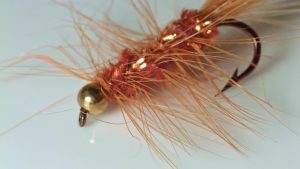 Most experienced anglers who go after salmon will probably tell you that the flies which are most successful in pursuit of these predatory fish are wet flies and salmon flies for salmon fishing.
Most experienced anglers who go after salmon will probably tell you that the flies which are most successful in pursuit of these predatory fish are wet flies and salmon flies for salmon fishing.
While some of these flies are specifically designed for salmon by using patterns that do not attempt to imitate any creature in particular, several are successful because they do a good job of impersonating some of the salmon’s natural prey.
Check out our selection of nymph flies – Click Here
Wet Flies
Wet flies are a broad category of flies, and include any fly that uses action under the surface of the water to entice a fish to bite. Terrestrial wet flies, for example, imitate a drowned insect. A salmon may take these wets out of curiosity while spawning, but generally for little other reason, since terrestrial insects are not a part of the salmon’s diet under normal circumstances.
Because the category of wet flies is so broad, however, salmon anglers don’t dismiss every wet as almost impossible to catch a salmon on. There are much larger versions of wet flies, and these come in a few different types, each designed to excite a salmon into biting for a number of reasons.
One of these types is the buzz bomb, which aggravates the salmon through emitting frequencies which vibrate through the water. Buzzers have typically relied on audio frequencies to entice salmon, but recent research indicates that certain species are likely to take a fly that manipulates the electrical frequency around it as well.
As this article is on wet flies and streamer flies for salmon fishing, it is necessary to skip over a few other wet flies that may work in order to give an accurate description of a much more specific wet fly variety.
Streamers
Streamer flies have proven to be successful in salmon fishing both in salt and fresh water environments. These flies imitate baitfish, which for most species of salmon make up the largest part of their diet. Streamers need to impart the same action a wounded baitfish would engage in if they are to attract and trigger the predatory response of a salmon in the ocean, so some skill is needed by the angler if success is to be had.
In a fresh water environment, streamers work not so much by triggering a feeding response as by triggering a protective response. Salmon who have entered fresh water do so to spawn, and their appetites are often diminished during this time.
At the same time, however, their aggression levels begin to peak; they are not only looking for mates but will also seek to protect any redd site they deem worthy. The presence of another fish, no matter how small, can be perceived as a threat and an aggravated salmon will strike.
Wet flies and streamer flies for salmon fishing, as in other types of fishing, have their best success rate when the angler understands the motives that will entice a salmon to strike the fly. This differs not only from one environment to another, but also from species to species. You should also remember to check local regulation when it comes to using salmon flies during the spawn; some runs are protected and molesting the fish is strictly prohibited.
